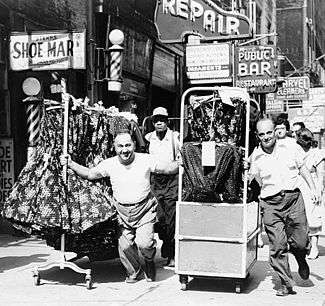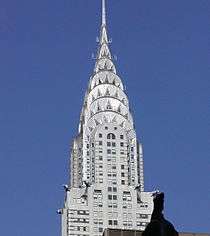Garment District, Manhattan
Coordinates: 40°45′13″N 73°59′20″W / 40.7535°N 73.9888°W

The Garment District, also known as the Garment Center, the Fashion District, or the Fashion Center, is a neighborhood located in the Manhattan borough of New York City. The dense concentration of fashion-related uses give the neighborhood its name. The neighborhood, less than 1 square mile (2.6 km2), is generally considered to lie between Fifth Avenue and Ninth Avenue, from 34th to 42nd Streets.
The neighborhood is home to many of New York City's showrooms and to numerous major fashion labels, and caters to all aspects of the fashion process from design and production to wholesale selling. The Garment District has been known since the early 20th century as the center for fashion manufacturing and fashion design in the United States, and even the world; no other city has a comparable concentration of fashion businesses and talent in a single district.[1]
Role in fashion
With $9 billion in annual sales in 2011,[2] New York City is the United States' top "global fashion city."[3] The core of the industry is Manhattan's Garment District, where the majority of the city's major fashion labels operate showrooms and execute the fashion process from design and production to wholesaling. No other city has a comparable concentration of fashion businesses and talent in a single district.[1]
The Garment District is home to a number of well-known designers, their production facilities, warehouses, showrooms, and suppliers of fabric and materials. Many in the industry allege that this dense concentration of talent, entrepreneurship and supply stores functions like an ecosystem in which each of the parts help sustain the whole.[4] Major fashion labels such as Carolina Herrera, Oscar de la Renta, Calvin Klein, Donna Karan, Liz Claiborne, Nicole Miller, and Andrew Marc have showrooms, production facilities, or support offices located in the Garment District.
While historically known as the center of textile manufacturing, global trends have changed the way the fashion industry in the Garment District functions. Over the last 50 years, New York’s garment manufacturing sector has experienced a steady decline within the City overall and within the Fashion District specifically. This has occurred as a result of domestic manufacturers becoming less competitive in the global marketplace, in addition to the outsourcing of clothes manufacturing to lower-cost foreign markets.
The decline of the manufacturing sector caused manufacturing in the Garment District to go down as well, and in 1987, the New York City government created the Special Garment Center District zoning (SGCD) to help preserve garment manufacturing. The zoning places manufacturing use restrictions on large portions of the district in an effort to keep manufacturing rents affordable.[5] However, the City’s use of zoning as a job retention tool did not achieve its goal, and manufacturing has continued to decline at the same pace after the zoning was enacted as it did before the preservation measures were in place. This issue has been visited and revisited by policy makers, fashion industry representatives, manufacturing and union representatives and owners of property in the district, but the fate of the district remains uncertain.
History
Early history

New York first assumed its role as the center of the nation's garment industry by producing clothes for slaves working on Southern plantations. It was more efficient for their masters to buy clothes from producers in New York than to have the slaves spend time and labor making the clothing themselves. In addition to supplying clothing for slaves, tailors produced other ready-made garments for sailors and western prospectors during slack periods in their regular business.
Prior to the mid-nineteenth century, the majority of Americans either made their own clothing, or if they were wealthy, purchased "tailor-made" customized clothing. By the 1820s, however, an increasing number of ready-made garments of a higher quality were being produced for a broader market. The production of ready-made clothing, which continued to grow, completed its transformation to an "industrialized" profession with the invention of the sewing machine in the 1850s. The need for thousands of ready-made soldiers' uniforms during the American Civil War helped the garment industry to expand further. By the end of the 1860s, Americans bought most of their clothing rather than making it themselves.
German and Central European immigrants to America around the mid-19th century arrived on the scene with relevant business experience and skills just as garment production was passing from a proto-industrial phase to a more advanced stage of manufacture. In the early twentieth-century a largely Eastern European immigrant workforce powered the garment trades. Writing in 1917, Abraham Cahan credited these immigrants with the creation of American style:[6]
Foreigners ourselves, and mostly unable to speak English, we had Americanized the system of providing clothes for the American woman of moderate or humble means. The average American woman is the best-dressed woman in the world, and the Russian Jew has had a good deal to do with making her one.[6]
With an ample supply of cheap labor and a well-established distribution network, New York was prepared to meet the demand. During the 1870s the value of garments produced in New York increased sixfold. By 1880 New York produced more garments than its four closest urban competitors combined, and in 1900 the value and output of the clothing trade was three times that of the city's second largest industry, sugar refining. New York's function as America's culture and fashion center also helped the garment industry by providing constantly changing styles and new demand; in 1910, 70% of the nation's women's clothing and 40% of the men's was produced in the City.
Decline of the industry
Cheaper overseas labor and production has dramatically affected the New York industry for decades. This change has forced many designers who once manufactured their lines in the city to shift production overseas, which has in turn affected small cutting and sewing rooms as well as zipper, button and supply stores in the Garment District.[7] As Charles Bagli of The New York Times wrote:
Some city officials and industry leaders worry that if manufacturing is wiped out, many of the designers who bring so much luster to New York will leave, along with the city’s claim to be a fashion capital rivaling Paris and Milan. The damage would be undeniable, given that the industry’s two big annual events—Fashion Week in September and February—attract enormous numbers of visitors and generate hundreds of millions of dollars in economic activity.— Charles Bagli, for the New York Times[7]
Although the Garment District as well as other fashion districts have been in decline, there are many organizations working hard to keep this district vital. One such organization is the Garment District Alliance, a nonprofit business improvement district that promotes the area as a strategic business location for fashion and non-fashion related-businesses in order to bring profit into the area.[8] For example, the Garment District Alliance organized a Fashion Walk of Fame on 7th Avenue, Arts Festivals, and a Garment District Information Kiosk located on 7th Avenue that provides sourcing information and industry-related services to fashion professionals, students, hobbyists, visitors, and shoppers.[9][10]
Save the Garment Center is a campaign that was created by several members of the fashion industry in an effort to preserve the concentration of fashion industry-related uses in the district. However, as fashion manufacturing declines, many buildings that once housed these large facilities have been converted to office space. Businesses such as accountants, lawyers, public relations and many high-tech companies have moved into the area, and the area is now divided equally between fashion and non-fashion companies.
Attractions
The Garment District is easily accessible, being within walking distance from Pennsylvania Station, serving the New Jersey Transit, Amtrak, and Long Island Rail Road; and from the Grand Central Terminal, serving the Metro-North Railroad. The New York City Subway, Port Authority Bus Terminal, and PATH are also nearby.
Landmarks include:
- The Fashion Walk of Fame, the only permanent landmark dedicated to American fashion[10][11]
- Needle threading a button – sculpture at the Fashion Center Business Improvement District's Information Kiosk at Seventh Avenue and 39th Street[9][12]
- Statue of Ralph Kramden in his bus driver's uniform – outside the Port Authority building[13]
- Greenwich Savings Bank Building
References
Notes
- 1 2 "The Fashion Capital". nycfashioninfo.com. Retrieved 2010-07-18.
- ↑ "FASHION IN NEW YORK CITY" (PDF). New York City Economic Development Corporation.
- ↑ Florida, Richard; Johnson, Sara (2012-09-07). "The World's Leading Cities for Fashion". CityLab. Retrieved 2015-11-13.
- ↑ "Made in Midtown". madeinmidtown.org. Retrieved 2010-07-18.
- ↑ "Article XII: Special Purpose Districts / Chapter 1: Special Garment Center District" (PDF). nyc.gov.
- 1 2 Cadle, N. (2008). The Mediating Nation: American Literature and Globalization from Henry James to Woodrow Wilson. University of North Carolina at Chapel Hill. p. 143. ISBN 978-0-549-53513-3. Retrieved 2015-11-13.
- 1 2 Bagli, Charles V. (August 19, 2009). "New York Seeks to Consolidate Its Garment District". The New York Times. Retrieved 2010-07-18.
- ↑ "Garment District Alliance". The Garment District Alliance BID. Retrieved 2010-07-18.
- 1 2 "The Fashion Center Information Kiosk". Fashion Center Business Improvement District. Archived from the original on November 1, 2009. Retrieved 2010-07-18.
- 1 2 "Walk of Fame". Fashion Center Business Improvement District. Archived from the original on July 20, 2009. Retrieved 2010-07-18.
- ↑ "Walk of Fame". fashioncenter.com. Retrieved 4 July 2012.
- ↑ "Needle threading a button in NY". virtualglobetrotting.com. Retrieved 4 July 2012.
- ↑ "Ralph Kramden Statue". roadsideamerica.com. Retrieved 4 July 2012.
Further reading
- Historical
- Dolkart, Andrew S. "The Fabric of New York City's Garment District," Buildings & Landscapes (2011) 18#1 pp 14–42.
- Fraser, Steven. Labor Will Rule: Sidney Hillman and the Rise of American Labor (Free Press, 1991);
- Goldstein, Gabriel, and Elizabeth Greenberg, eds. A Perfect Fit: The Garment Industry and American Jewry, 1860-1960 (2012) its origins in the nineteenth-century “rag trade” of Jewish tailors, cutters, pressers, peddlers, and shopkeepers
- Green, Nancy L. Ready-to-Wear and Ready-to-Work: A Century of Industry and Immigrants in Paris and New York (Duke University Press, 1997);
- Helfgott, Roy B. "Women's and Children's Apparel," in Max Hall, ed. Made in New York: Case Studies in Metropolitan Manufacturing, (Harvard University Press, 1959)
- Parment, Robert Parmet, The Master of Seventh Avenue: David Dubinsky and the American Labor Movement (New York University Press, 2005).
- Soyer, Daniel, ed. A Coat of Many Colors: Immigration, Globalism, and Reform in the New York City Garment Industry (Fordham University Press, 2005)
- Tyler, Gus. Look for the Union Label: A History of the International Ladies Garment Workers' Union (M. E. Sharpe, 1995)
- Waldinger, Roger D. Through the Eye of the Needle: Immigrants and Enterprise in New York's Garment Trades (New York University Press, 1986)
- Contemporary
- Rantisi, Norma M. "The local innovation system as a source of'variety': openness and adaptability in New York City's garment district." Regional Studies (2002) 36#6 pp: 587-602.
- Rantisi, Norma M. "The Competitive Foundations of Localized Learning and Innovation: The Case of Women's Garment Production in New York City." Economic Geography (2002) 78#4 pp: 441-462.
External links
| Wikimedia Commons has media related to Garment District, Manhattan. |
